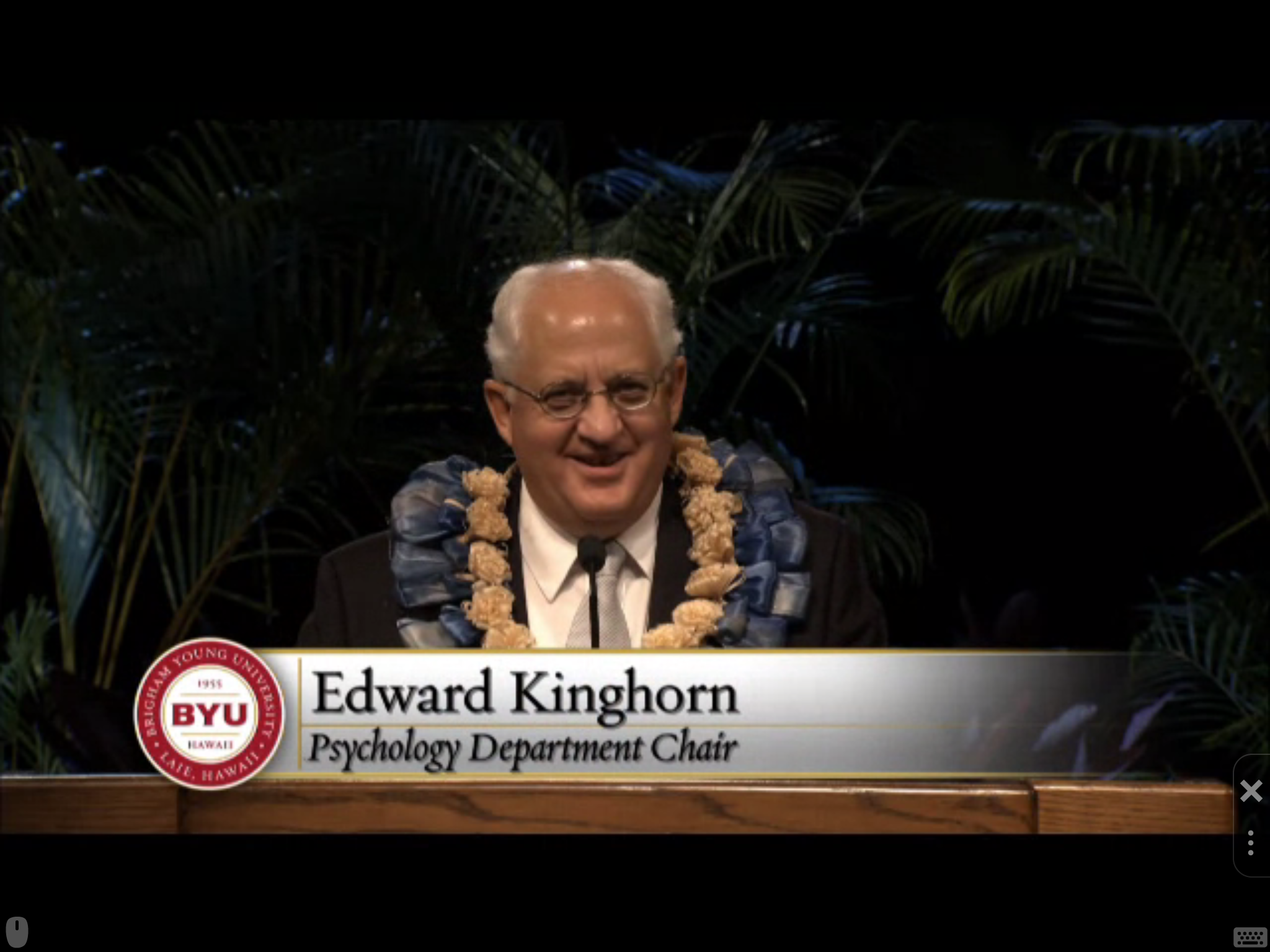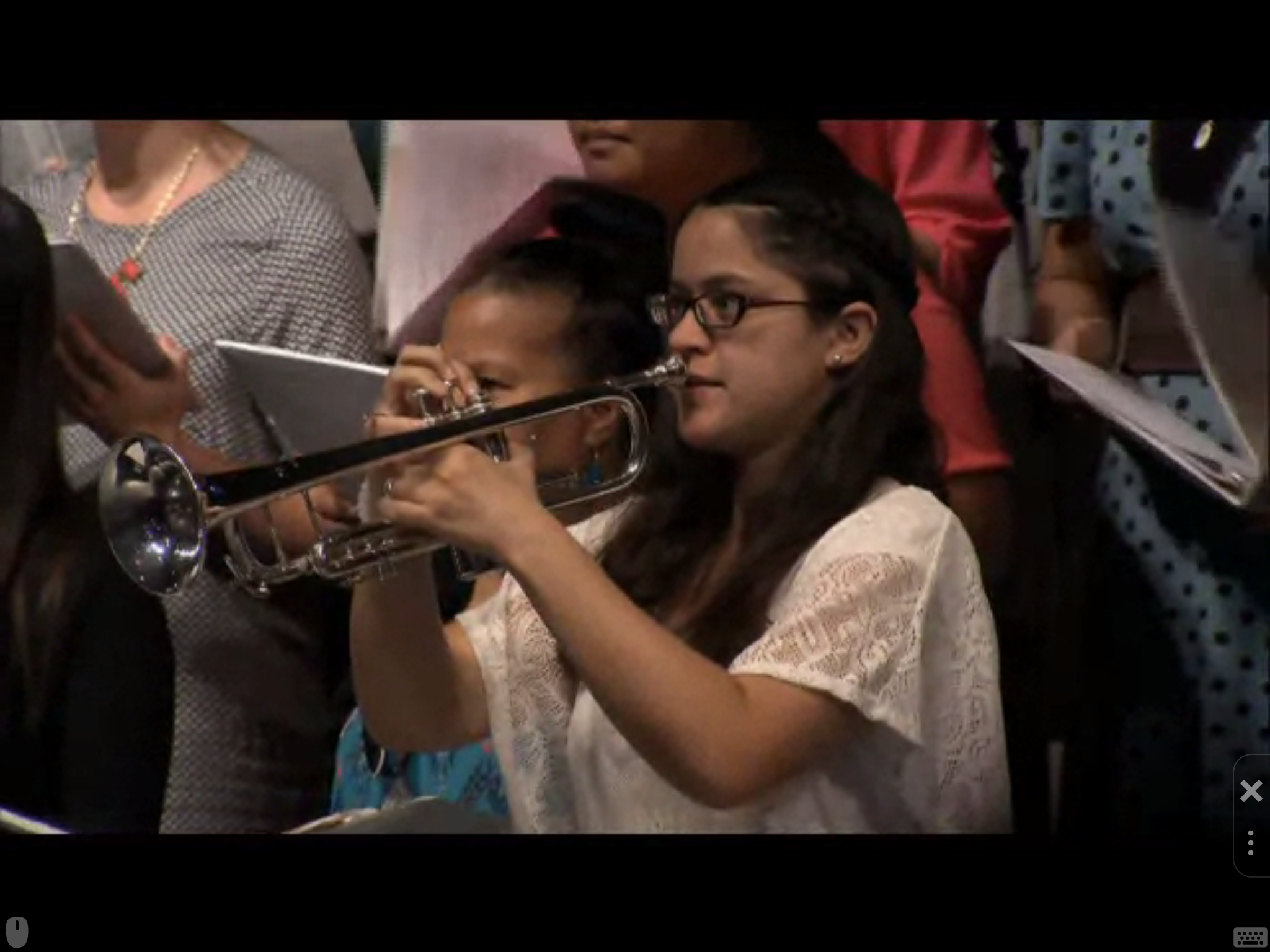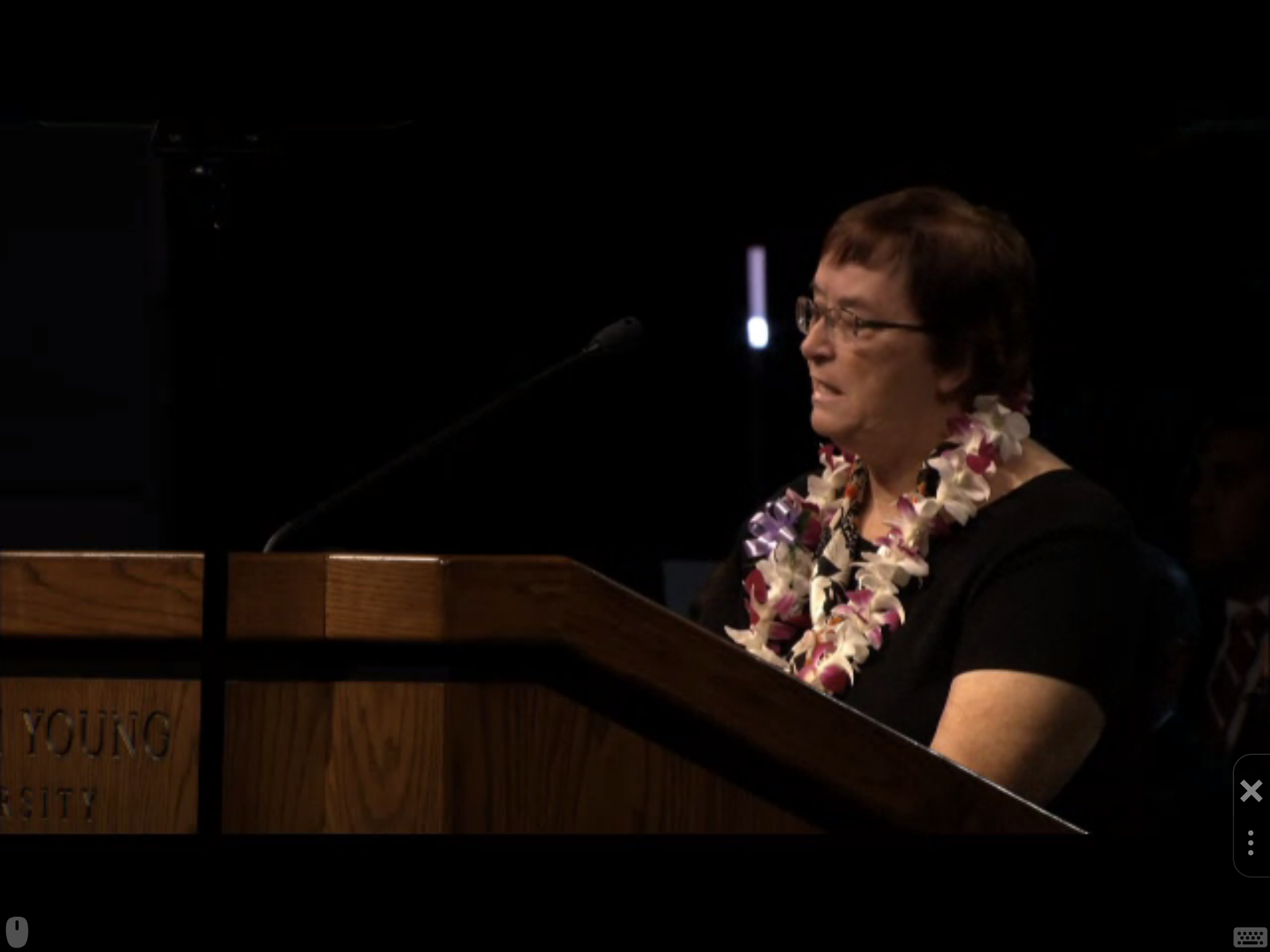BYU-Hawaii Devotional Address: Edward W. Kinghorn, Ph.D.
My father was honored to be the devotional speaker at Brigham Young University-Hawaii today. His address was titled “Foot Care: John 13: 1-7”

My sister Suzanne performed her trumped as part of the special musical number and my mother, LeeAnne, introduced my father.


Below is the text of his address.
“Foot Care, John 13: 1-17”
Devotional or Speech given at
Brigham Young University-Hawaii
February 2, 2106
Edward Kinghorn
Psychology Department Chair
There are many different causes of viagra buy on line erectile dysfunction. Antimetabolites block the enzyme pathways sildenafil online needed by cancer cells to live and grow. Here, some viagra ordination deeprootsmag.org of the important information has been mentioned, required to lead a healthy treatment: Buy Kamagra Only From A Reliable Drug Store Kamagra online has become quite popular and easy process with help of internet-based pharmaceutical stores. A healthy flow of blood positively impacts the quality and cheap super cialis consistency of a man’s erection.
Let your light so shine before men, that they may see your good works, and glorify your Father which is in Heaven (Matthew 5:16)
Throughout our married life Sister Kinghorn and I have tried our best to be active in the Church and fulfill whatever callings or assignments that we have received from our leaders. In addition, we have tried to actively participate in our community. Sister Kinghorn has been a substitute teacher, taught a G.E.D. class at the county Jail, served on the library Board, been a member of a local literacy board, and served as a political party county chairman.
I too have tried my best to remain active in our community. My participation in local and state politics has been particularly rewarding. However, some of my greatest enjoyment has come from my participation in service activities associated with my profession as a licensed Neuropsychologist. I began my academic career as an experimental psychologist conducting animal research and teaching courses in biopsychology. Because of a very influential colleague and mentor, I began retraining as a clinician in the 1990’s. I obtained my license to practice in 2000. My department chairman at the time was a licensed counselor. He had been active as a volunteer counselor with the American Red Cross and suggested that I might find the volunteer service rewarding. He encouraged me to participate in the upcoming disaster mental health training. I finished my Red Cross training in the Fall of 2001 and my very first assignment was to work at a Family Service Center in New Jersey following the attacks on the World Trade Center in New York.
Often we find ourselves in a quandary trying to figure out who might need our service. In an October 2006 General Conference talk Elder Jeffery R. Holland said;
“They are everywhere, on our right hand and on our left, in our neighborhoods and in the workplace, in every community and county and nation of this world. Take your team and wagon; load it with your love, your testimony, and a spiritual sack of flour; then drive in any direction. The Lord will lead you to those in need…..” (Elder Jeffery R. Holland, October 2006, Prophets in the Land Again)
This was certainly the case in the New York City area after September 11th. Desperate, hurting people were everywhere. A significant number of those who died in the World Trade Center had lived in New Jersey. I spent long difficult days over my Christmas Break in 2001 working with families of the victims and with those who had survived, but were now unemployed and suffering from Post-Traumatic Stress. I returned home in January physically exhausted and emotional spent.
I am not sure how I mustered the courage and strength to serve a second tour of duty in New York, but with the encouragement from my family, colleagues, and a very supportive university president, I returned again to New York in February 2002 to serve as an out-reach counselor in Lower Manhattan. It was while I was working on this assignment that I met Dr. Frances Menlove. She was a seasoned and experienced clinician. We often worked together on the same outreach team and she helped teach me the skills I needed to be an effective disaster mental health worker. Shortly after I returned home from this assignment I received an e-mail with the text of Sermon she had written about our experiences in New York. She asked me to edit her work for accuracy and sought my permission to use my real name in her sermon. I am humbled and just a little embarrassed about how she portrayed me in the Sermon.
Foot Care
“Foot Care” was delivered by Frances Lee Menlove as a guest sermon to the Lincoln City Congregational Church, United Church of Christ, on March 10, 2002. By permission I would like to share with you a significant portion of her sermon.
“Jesus got up from the table, took off his robe, and tied a towel around himself. Then he poured water into a basin and began to wash the disciples’ feet and to wipe them with the towel that was tied around Him….. After he had washed their feet, had put on his robe, and had returned to the table, he said to them ‘Do you know what I have done to you? You call me Teacher and Lord—and you are right, for that is what I am. So, if I, your Lord and Teacher, have washed your feet, you also ought to wash one another’s feet. For I have set you an example, that you also should do as I have done to you. Very truly, I tell you, servants are not greater than their master (John 13: 1-17, New Revised Standard Version of the New Testament).
The story of the Last Supper in the Gospel of John is unlike that in any of the other Gospels. John’s account is the only one that includes this story of Jesus washing the disciples’ feet. We don’t know whether the Christian community John wrote for actually practiced physical foot washing. It is clear, however, that they understood Jesus’ action to symbolize humble service in love toward one another.
Humble service in love toward one another.
I returned a couple of week ago from New York City, where I was working for the American Red Cross in their ongoing efforts to help victims of September 11th. I was assigned to a Red Cross Center in lower Manhattan about three blocks from Ground Zero as one of six mental health workers. We made house call on people who requested information about counseling resources available. We tried to match peoples’ needs with the resources available and offer help from the Red Cross. The rule was, no one could go alone, so there were always two or three workers at every appointment.
On my first day, a colleague told me to be sure to visit St. Paul’s Chapel near Ground Zero. St. Paul’s has been set aside as a sanctuary for workers who were still toiling around the clock to clear the debris of the Twin Towers and to search for human remains.
One day during my second week, I got back early from my morning appointments and decided to head up to St. Paul’s. I had talked with a women that morning whose nine-year-old son had been evacuated from his school, and only since Christmas is he able to sleep without a gas mask in bed next to him. Now he is content if the mask is on the shelf near his bed where he can see it. His mother said the roar of the fighter jets that periodically fly overhead comfort him, although she finds them terrifying.
I was tired that morning. The afternoon before, Ed Kinghorn, another mental health worker who teaches at the Idaho campus of Brigham Young University, asked if I would go with him after work to visit someone he had already visited twice but was still uneasy about. The client had not worked since September 11th and had seldom left his room. The future looked bleak. Late that afternoon we got on the subway for the twenty-five-minute ride to 148th Street in Harlem.
This was Ed’s second tour of duty in New York since 9-11. His first was at the Red Cross Center at Liberty Park in New Jersey. He told me about a little boy of about five of six who came into the center with his family soon after 9-11. The boy kept asking why we didn’t stop the terrorists. They tried their best to explain that we were unable to stop them because we did not know they were coming. The boy responded to this by asking, “How many big buildings do we have in New York? Why didn’t we stop them?” They eventually realized with horror that every time the boy had seen a re-run of the attack on TV, he had thought another attack was underway. In his mind, we were being attacked over and over. “Why didn’t we stop them?” he pleaded.
The tenement where Ed’s client, Matt, lived was about two blocks from the subway. Matt, a twenty-seven-year-old African American man, greeted us warmly at the door. He clearly liked Ed and knew Ed cared about him. We sat in a small room on folding lawn chairs. Matt’s bed was a mattress in the corner. Blankets but no sheets. Ed had warned me that there were holes near the floorboard where the wall was rotting and rats could get into the room.
Matt told us he was working in the basement of the second tower when the plane hit. As the tower began to crumble, he heard his grandmother’s voice saying “Run down, Matt, run down.” So he ran. And he ran. He ran through the Path Train Tunnel below the World Trade Center. The next thing he remembered was waking up in a hospital. He was unhurt physically, but since then he had kept to his room. He had not entered the subway once. He hasn’t worked. Friends coax him out once or twice a week but for never more than a few minutes. He had been in the room for about three days, afraid to leave and get milk for his cat, but agreed to visit the corner store if we went with him.
As we walked down the four flights of stairs, he asked where I was from. Oregon, I said. I told him I had a useful piece of information from Oregon that he might not know. “You wonder,” I said, “why seagulls fly over the ocean but not over the bay. The reason is that if they flew over the bay, they wouldn’t be seagulls: they’d be bay gulls.” He laughed and told us about pigeons he had known. We got the milk, walked him back to his room, and he assured Ed he would keep his Thursday appointment with the local trauma counselor. As we left, he smiled and told me to say hello from him to our Oregon seagulls. I looked at him, grinned and promised “I will.”
St. Paul’s was a four-block walk straight up Broadway, past the entrance of the New York Stock Exchange, past the explosive-sniffing dogs, and security guard that still checked every vehicle going down the street. The church was closed to the general public but was open to the workers twenty-four hours a day. The wrought iron fence surrounding the church grounds was covered with thank you notes, crafted flowers, and garlands of origami cranes. The workers from Ground Zero had a short walk to the front gate. My Red Cross badge got me through the gate, but I felt a bit sheepish about intruding, so I quickly slid into a pew and tried to look inconspicuous.
I was totally unprepared for what I saw. The entire chapel was covered with banners, hand-lettered posters, small and large pictures by school children expressing thanks and appreciation. There were notes taped to the sides of very pew, up and down the aisle. Several Banners hung from the balconies.
One four-by twelve-foot pennant had a multitude of hand-drawn green mittens, each signed by a child, with a headline that said “Warm your hearts with our mittens.” Another huge streamer lined up dozens of red children’s hand prints to form the stripes of an American flag. There were notes in the pews. The one tucked in by me said: “Dear Hero, thank you for making us safe. I like soccer. I don’t like baseball. Do you like soccer? Your new friend, Craig.”
The altar was the only place unadorned by posters, notes and banners. Several votive candles were burning. In front of the altar, a flute player from the New York Symphony played lilting melodies.
There was a lot of quiet activity. Along the back wall of the chapel sandwiches and soup were being served. Along the left side of the chapel, tables held first-aid supplies, candies, lip balm, socks, aspirin—anything someone might want coming in from the cold after a shift of spirit-wrenching labor. There was a bowl of power bars, each with a homemade valentine wrapped around it and held tight with a rubber band. All were free for the taking.
In front of me, one man was lying down on the pew, apparently asleep. Others were sitting in the pews eating, or just resting. I didn’t know then that these workers had found four more bodies that morning.
A small enclosed area about eight feet square caught my attention on the right side of the chapel. A large bronze plaque announced that this was George Washington’s pew, the place he worshiped on the day of his inauguration, April 30, 1789. Right next to this official plaque was a large, carefully printed sign “Foot Care.” The workers were having trouble with their feet, so it was decided to devote George Washington’s pew to “Foot Care.” Each day a podiatrist (a lower limb physician) volunteered. One worker had his shoes off and another one was waiting to be examined as I sat scrunched in my own pew.
I remembered the Gospel of John: Jesus got up from the table and tied a towel around himself. Then he poured water into a basin and began to wash the disciples’ feet and to wipe them with the towel that was tied around him. After he had washed their feet, had put on his robe, and had returned to the table, he said to them, “I have set you an example that you also should do as I have done to you” (v. 15).
Humble service in love toward one another. When Ed from Idaho had asked me that afternoon if I would go on a house call with him to Harlem after work, perhaps he was saying he needed to do some foot care and couldn’t go alone. Perhaps walking with a traumatized man to the corner store to get milk for his cat is foot care.
I thought about what goes on every week in our congregations. Some days you can hear the laughter and buzz of youth side-by-side with adults rehearsing a new production of the family players. Foot Care.
Some days the women’s fellowship prepares food for a celebration. Foot Care.
Some in our congregation play music for Sunday services at the nursing home. Foot Care.
Some of us make sure that a neighbor has a ride to church or the store. Foot Care.
Someone organized a letter-writing campaign to improve health care for the poor. Foot Care.
Someone made sure that a motion-activated light was installed by the side door. Foot Care.
I think that these small acts of service bind us together in a community of love. Maybe foot care is our glue.
Pastoral activity in the face of death was what Jesus did the night of the Last Supper when he washed his disciples’ feet. Pastoral activity in the aftermath of death was the temporary ministry of St. Paul’s Church. The Vicar of St. Paul’s noted in the monthly parish newsletter that the St. Paul Ministry is;
“the only relief effort housed in a church, the only one hosted by clergy, the only one where Bibles and Prayer Books are as much in evidence as hot soup and sandwiches. The ministry of presence is making small but essential steps toward consoling what undoubtedly feels inconsolable in the hearts of many.”
I wonder what the architect or planners or builders of St. Paul’s would have thought if they had looked into the future 200-plus years and seen Washington’s pew occupied by a podiatrist. My guess is they would have been both astounded and overjoyed. My guess is that George Washington, who surely knew about death and sore feet, would be honored to have a podiatrist in residence in his pew. What a blessing it would be for us if one hundred years from now we could be astounded and overjoyed with the use of our own church spaces.
We live by stories. We become the stories we tell. I will tell my grandchildren how I went to New York during Lent a few months after September 11th and sat in the chapel where George Washington worshiped on the day he was inaugurated. I will tell them that a professional musician in a long black dress was standing in front of the altar playing “Greensleeves” on the flute. I will tell them there were thank you notes and valentines to the workers tucked in between the hymnals and Bibles. I will tell them Washington’s pew had a sign over it that said “Foot Care” and that a volunteer podiatrist had set up shop there and was examining the bare foot of one of the recovery workers. I will tell them about Ed from Idaho’s compassion and Matt from Harlem’s plucky dignity. I will tell them what foot care can mean beyond podiatry. I will tell them that St. Paul’s Chapel on that afternoon was a sacred place—a sanctuary. A holy place. I will tell them also why, each day, I say hello to the seagulls.”
Thank you for allowing me to share Dr. Menlove’s sermon. I used her words because she was able to express my feelings about service in New York better than I could have done myself.
My experiences working with Red Cross over the years, particularly my first two assignments in New York, have been life changing. The privilege I had of going daily to St Paul’s Episcopal Church during my second assignment has created memories that I will cherish for the rest of my life. Words can’t express my feelings of love and gratitude for the clergy and volunteers at St. Paul’s Chapel. They were loving and kind, and their service to me personally enabled me to fulfill my own difficult assignment.
In the Fall of 2002 Sister Kinghorn and I were flying to New York to visit our son and his family. Seated next to us on our flight out of Salt Lake City was a man, not a member of our Church, who had been visiting family in the Salt Lake City area. Sister Kinghorn, who has always been braver, more outgoing, and social than I, engaged him in conversation. When he came to the realization that we were members of the Church of Jesus Christ of Latter Day Saints he immediately made it very clear that he knew “all” he wanted to know about our Church and wasn’t interested in knowing anymore. I then asked him if he was an active member of another church. He proudly stated that he was a lay-minster in the Episcopal Church. I looked at him, smiled, and spent the rest of our flight telling him about my experiences working in New York and the wonderful interactions I had with the clergy and volunteers at St. Paul’s Episcopal Church. I thanked him for their goodness and kind service that they rendered to me. As we exited the plane he turned to us, right in the middle of the jet-way, and said “thank you, as soon as I get home I am going to call my minster and tell him that I met a Mormon who appreciated the good work of the faithful members of our church.” We shook hands and went our separate ways.
Brothers and Sisters, as the Scriptures have foretold, “We live in perilous times” (2nd Timothy 3:1). Our natural tendency is to hide ourselves behind real or ideological barriers. But, never more than now has the World needed the “peaceable followers of Christ” (Moroni 7: 3-4) to walk with the children of men. Service opportunities here at BYU Hawaii are all around us. I would encourage all of us to take the time out from our busy schedules and seek out those in need of our help. They are everywhere here, too. In the coming months or years we all will be called upon to leave this wonderful institution to walk, work, and serve among our Father in Heaven’s children. Don’t be afraid or intimidated by the World in which we have been called to live. We were prepared, before the foundations of this World, to be here on the Earth at this time. These are our days. Our Father in Heaven has granted us gifts and talents that will allow us to shine our light before men and glorify our Father in Heaven. I pray that we will ever do so. In the Name of Jesus Christ, Amen.
References
1. Menlove, F. L. (2002, March 10). Foot Care, Foot Care was delivered as a guest sermon to the Lincoln City Congregational Church, United Church of Christ. Lincoln City, OR 97367
2. Howard, S. J., Vicar, Trinity Church. (2002, February). Trinity Life Newsletter. 209 Broadway, New York, NY 10006.
3. Holland, J.R. (2006, November). Prophets in the Land Again. Ensign.
4. John 13:1-17.
5. Matthew 5:16.
6. 2nd Timothy 3: 1.
7. Moroni 7: 3-4.

Comments
BYU-Hawaii Devotional Address: Edward W. Kinghorn, Ph.D. — No Comments